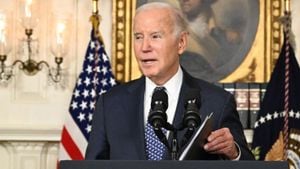Kamala Harris’s presidential campaign for 2024 has unfolded amid a backdrop of challenges familiar to many candidates: carrying the weight of party expectations, dealing with the imprint of her predecessor’s policies, and responding to voters’ changing concerns. Harris, who aimed for the presidency against Donald Trump—facing the scrutiny of being the first woman of color to hold such ambitions from her party—found herself not only fighting for survival within the Democratic Party but grappling with how to resonate with everyday Americans, particularly those who felt left behind by years of economic upheaval.
The race started under the cloud of President Joe Biden’s dismal approval ratings. With Americans feeling the continued sting of inflation and witnessing deepening economic anxieties, Harris had to confront significant challenges head-on. Her campaign manager’s strategy seemed misaligned with the realities ordinary voters faced, leading to sharp criticisms about the disconnect between Harris’s messaging and the electorate’s pressing concerns.
Surveys indicated voters’ top priorities were clear: inflation, job security, and concerns about immigration. Yet, Harris’s campaign leaned heavily on issues such as abortion rights and the future of democracy, which, though undeniably important, appeared secondary to the voters. This approach raised eyebrows, particularly as the campaign strategists, many of whom had ties to Biden's administration, seemed to underestimate the urgency of addressing the immediate economic concerns facing the American populace.
While Harris had the financial firepower to mount her campaign, thanks to substantial fundraising capabilities and backing from various establishment figures, including celebrities like Oprah Winfrey, these endorsements did not translate to successful voter outreach. Winfrey famously hosted glamorous town halls, targeting those disenchanted with the political discourse, but Harris’s reliance on this star power did little to alleviate the worries of working-class voters.
What’s more, Harris’s ability to craft relatable campaign messages was hampered by the stark reality of how the political tenor had shifted since significant legislation was passed, like the Dobbs decision on Roe v. Wade and various efforts on immigration reform. With many states surprisingly reinforcing reproductive rights, Harris’s framing of the abortion issue did not land as she had hoped. For voters prioritizing economic recovery, talking about abortion might have come off as tone-deaf.
Adding to her troubles, misinformation and right-wing narratives had begun to seep deeply through American discourse. Many voters, particularly those with lower socioeconomic backgrounds, did not follow the headlines closely and were swayed by powerfully delivered messaging from Trump and his allies. The Republican narrative painted Biden's policies as failures, particularly concerning inflation and job loss, which presented substantial obstacles for Harris. Her attempts to counter this narrative were characterized more by reactions than proactive solutions.
The strategic missteps didn't just stop at the primary issues of abortion and economy; they extended to immigration. Attacks on Harris often featured claims about her ‘unilateral’ immigration approaches, though the administration had made attempts at bipartisan solutions. Voters, tired and frustrated with the polarization surrounding immigration policies, were left wanting substantive proposals rather than platitudes about commitment. Harris’s team might have benefitted from proposing tangible measures to control immigration, which could have reconciled her policies with voter sentiment.
Harris’s messaging could have drawn inspiration from historical figures like JFK or Jimmy Carter, who successfully highlighted economic struggles and personalized them through direct communication with corporate leaders. Drawing on the public’s sense of desperation and asserting ambitious economic proposals could have transformed her image among undecided voters.
Indeed, the path to victory veered off-course when voters perceived Harris as part of the same establishment politics they wished to change. While her administration touted significant economic achievements—such as historic job growth—this message failed to properly resonate with communities on the ground. Voters’ general ignorance about the administration’s success only compounded Harris’s credibility problem.
Her recipes for success, as laid out by various pundits, included promoting training programs for workers, lowering costs for small businesses through tax cuts, and directly engaging voters about the tangible benefits of improved economic policies. Activists stressed the urgency of connecting with blue-collar workers, who—understandably—might feel adrift amid changes to their work environments due to tech advancements and globalization.
It is evident no singular miscalculation led to her defeat. Instead, Harris contributed to her own challenges through persistent misjudgments about what issues mattered to the electorate and how to effectively communicate her position on those issues. The campaign presentation faltered, showcasing her inability to craft coherent economic solutions, especially for groups deemed swing states—a demographic key to her campaign's success.
The culmination of such challenges turned out to be Harris’s credibility issues, rooted deeply within the voters’ discomfort with her perceived connection to the administration. Even as she endeavored to tackle important social issues, the ever-evolving concerns of the American public necessitated detailed engagement and solutions—strategies her campaign didn’t utilize effectively.
After the grueling election and the accompanying discourse, Harris and her team are left with significant introspection to assess what went awry. How could her campaign have failed to predict the centrality of the economy, jobs, and immigration to voters? The lessons learned following this campaign will undoubtedly shape the Democratic strategy moving forward.
Despite the setbacks, there were moments of authentic connection, glimpses of hope as Harris engaged with voters directly, showing her genuine desire to improve lives. Moving forward, she remains positioned as an influential figure within the Democratic Party, and the evolution of her policies and presence could redirect public perception as she contemplates future endeavors. Now perhaps more than ever, her voice is pivotal within party dynamics and necessary for shaping the future of Democratic messaging.



